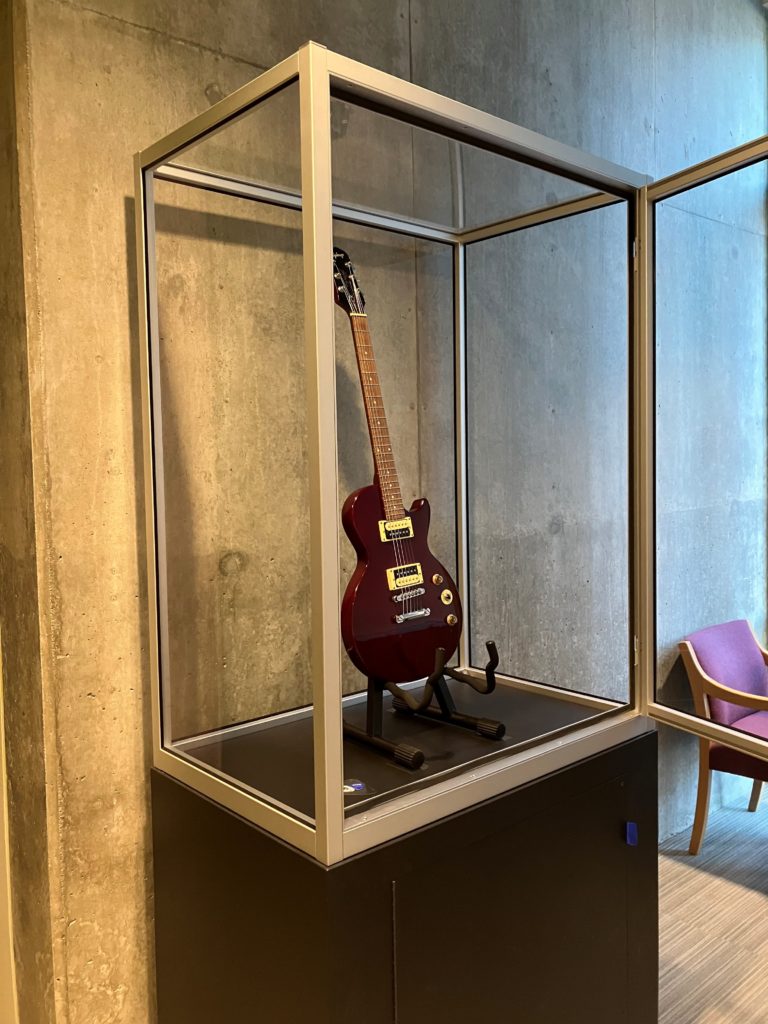In 2021, thanks to a generous Foundation for Advancement in Conservation (FAIC)/Tru Vue® Conservation and Exhibition Grant, the Museum of Pop Culture (MoPOP) was able to build a guitar case under the guidance of conservator Lisa Duncan’s recommendations. This project provided museum staff with the opportunity to implement action forward thinking ideas regarding the preservation of 20th and 21st century artifacts.
MoPOP Collection Background
The iconic artifacts in our care – such as Eric Clapton’s legendary “Brownie” Fender Stratocaster or Howlin’ Wolf’s 1965 Epiphone Casino electric guitar – have directly inspired artists and pop culture lovers for decades, and now, as part of MoPOP’s collection, their history directly engages, connects, and excites our visitors. In developing this collection, MoPOP preserves a rich musical legacy and provides the foundation for public programs and exhibitions that explore broader socially relevant themes tied to popular culture. MoPOP currently houses over 80,000 artifacts in its permanent collections.
Our in-house produced exhibitions combine artifacts from our permanent collection as well as from lenders in order to thoroughly examine how contemporary popular culture influences the world around us. Using artifacts from pop culture, our exhibitions and activities delve into the undercurrents of popular culture that continually shape and reshape our society. Our collection and its interpretation through programs, education, and exhibitions harnesses the relevancy of pop culture while safeguarding diverse histories for future generations. (For example, Woodie Guthrie’s guitar displayed in Play On is the inspiration for our teacher training session on how pop culture has been used for protest in American History).
A wide variety of object types from our permanent collection may be on display and subject to the environmental conditions of our museum. With this in mind, the museum works with conservators, focused on objects and 2-D artifacts, to ensure the needs of all future artifacts for galleries are taken into consideration when making future plans.
Tru Vue/FAIC project
Guitars from our collection feature a high number of plastic and other chemically unstable materials. In order to mitigate this, our collections and exhibits teams examined the idea of creating microclimate casework to house the current artifacts in space. However, our conservation consultant suggested that the component materials of our guitars – namely the mid-20th century plastics and varnish – are in a state of slow and inevitable degradation that would be hastened by enclosing these materials in air-tight cases.
The FAIC/Tru Vue grant enabled MoPOP to work directly with a conservation consultation, using Tru Vue glazing, in order to address these concerns in the fabrication of a guitar case.
Final Product
The goal of this project was to make a case that the chemical by-products of the degradation can vent from and not continue to exacerbate the plastic decomposition process. Acrylic was chosen due to its relatively low permeability compared to glass and proven use in sealed microclimate enclosures.

The final display guitar case was built with the overall dimension 38” x 83” x 24”. Marvelseal® was utilized inside the casework to prevent casework materials from contributing to an adverse environment, and wood was limited in casework designs (wood acids drive deterioration). The case includes a powder coated steel desiccant sink below the floating Medite® deck of the case.

The base of the exhibition case is accessed with a swinging door. Staff can access the interior desiccant tray through the portal hole. The desiccant portal door can be left open if additional ventilation is needed or closed to create a microclimate environment.

Silver, copper and lead coupons were placed in the case for assessment in the first couple months after completion. The case off-gassed for several months, with the coupons acting as a canary in the cage for any residual gas in the case. A-D strips purchased from Image Permanence Institute were also placed near the case deck for observation of any acetic acids.

Overall the case is an excellent home for the guitars in the care of our collection as they go on display in our museum.

Share this Article:
This article is intended for educational purposes only and does not replace independent professional judgment. Statements of fact and opinions expressed are those of the author(s) individually and, unless expressly stated to the contrary, are not the opinion or position of Tru Vue or its employees. Tru Vue does not endorse or approve, and assumes no responsibility for, the content, accuracy or completeness of the information presented.
